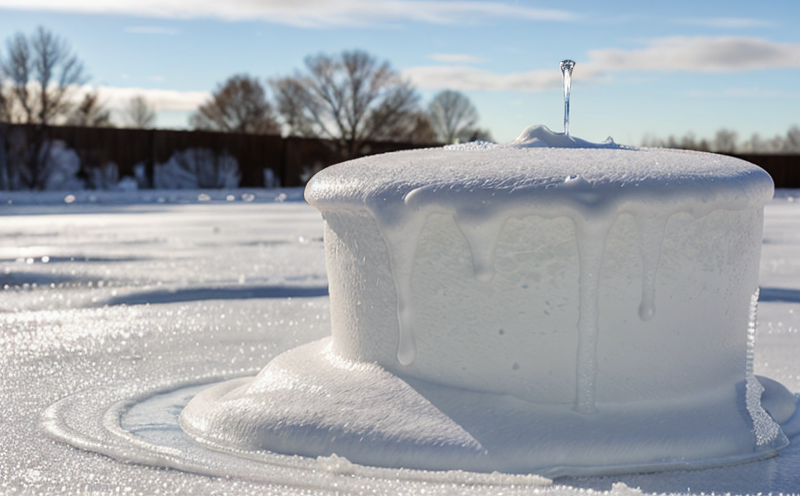ASTM F2114 Aircraft Electrical Heater De-Icing Testing
The ASTM F2114 standard provides a method for determining the effectiveness of aircraft electrical heater de-icing systems. This test is crucial in ensuring that aircraft can safely operate under icing conditions, which are prevalent during winter flights and at high altitudes where supercooled water droplets form ice on exposed surfaces.
Aircraft icing can lead to catastrophic failures if not properly managed. Electrical heaters installed on wings, fuselage, and other critical components play a vital role in preventing this hazard by melting the ice before it can accumulate. The ASTM F2114 test simulates real-world icing conditions using controlled environments to evaluate heater performance.
The test involves exposing an aircraft component or mock-up to a controlled frost environment where ice forms on its surface. Then, an electrical heater is activated, and the amount of ice melted by the heater over time is measured. This measurement provides insights into the heater's efficiency and reliability in melting ice under specific conditions.
The apparatus used for ASTM F2114 includes a chamber capable of creating frost and controlled temperature gradients, sensors to measure ambient temperatures and ice thickness, and electrical heaters with known power outputs. The specimen preparation involves securing the component or mock-up onto the test rig within the chamber. This setup allows for precise control over environmental conditions.
The acceptance criteria are based on predefined melting rates that indicate whether the heater meets performance standards set forth in ASTM F2114. If the heater fails to meet these criteria, further modifications may be required before the component can pass inspection.
| Parameter | Description |
|---|---|
| Frost Chamber Temperature Range | -20°C to -40°C |
| Humidity Control | 95% RH ± 1% |
| Heater Power Output | Varies depending on specimen size and type |
| Melting Rate Criteria | >80% melting within 30 minutes for critical areas |
This testing ensures compliance with aviation safety regulations, helping to prevent accidents caused by ice accumulation. By rigorously evaluating de-icing systems through ASTM F2114, manufacturers can enhance product reliability and customer confidence.
Benefits
- Enhanced Safety: Ensures aircraft components are free from ice accumulation, reducing risks associated with icing conditions.
- Regulatory Compliance: Meets international standards for aviation safety and quality assurance.
- Improved Product Reliability: Identifies performance issues early in the development process.
- Cost Savings: Prevents costly delays due to non-compliance by identifying potential problems during testing rather than after deployment.
The ASTM F2114 test provides a robust framework for assessing de-icing systems, ensuring that they function reliably under expected operational conditions. This not only enhances safety but also supports continuous improvement in aircraft design and maintenance practices.
Why Choose This Test
- Proven Standard: ASTM F2114 is widely recognized and accepted by regulatory bodies worldwide.
- Real-World Simulations: The test closely mimics actual in-flight icing scenarios, providing accurate performance data.
- Comprehensive Evaluation: Evaluates both the heater's melting capability and its ability to maintain ice-free surfaces over time.
- Cost-Effective: Identifies issues early on, reducing the need for extensive post-production modifications or recalls.
Selecting ASTM F2114 testing demonstrates a commitment to safety and quality, which is critical in the aerospace industry. By adhering to this standard, organizations ensure they meet regulatory requirements while also enhancing their reputation through proven reliability and performance.
Use Cases and Application Examples
- Aircraft Wing De-Icing: Ensures that wings remain ice-free during takeoff and landing, preventing structural damage and improving aerodynamics.
- Fuselage De-Icing: Prevents icing on the fuselage, which can affect visibility and increase drag, impacting fuel efficiency.
- Keeps propellers free from ice buildup to maintain optimal performance and prevent power loss.
The following table provides specific use cases and application examples for ASTM F2114 testing:
| Component | Purpose of Test |
|---|---|
| Airframe Components | Evaluating heater effectiveness on critical surfaces like wings, fuselage, and tail. |
| Turbine Blades | Ensuring that ice does not form on blades which could lead to blade failure. |
| Windshield De-Icing: | Verifying that windshield heaters effectively remove ice without causing damage or compromising visibility. |
ASTM F2114 testing is essential for any component where ice accumulation could compromise safety, performance, or operational efficiency. This test plays a pivotal role in the development and certification of aircraft systems, ensuring that they meet stringent safety standards.





